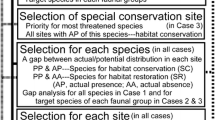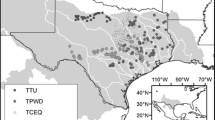Abstract
The Government of Canada is considering a recommendation by the Committee on the Status of Endangered Wildlife in Canada to list shortjaw cisco (Coregonus zenithicus) as “Threatened” throughout its range under the Species At Risk Act (SARA). If the listing is approved, shortjaw cisco will receive legal protection, including protection for its ‘critical habitat.’ This study focused on habitat characteristics associated with specimens identified as shortjaw cisco collected with targeted sampling in Lake Huron of the Laurentian Great Lakes. Competing habitat-use models were developed using available data for three physical habitat variables: Water Depth, Substrate Slope, and Cliff Distance, and the models were evaluated using binary logistic regression and ranking of Akaike information criteria. For the habitat factors examined, Water Depth was the most important variable for explaining the observed distribution of identified shortjaw cisco, although this factor alone was not sufficient to adequately represent habitat for this taxonomically uncertain and rare animal. Future habitat discrimination for this hypothesized species at risk must be based on (a) reduction of taxonomic uncertainty, (b) expansion of sampling effort, and (c) consideration of additional physical and ecological habitat factors.


Similar content being viewed by others
References
Bajkov A (1932) The genus Leuchichthys (ciscoes or tullibees) in Manitoban waters. Contrib Can Biol Fish 7:144–159
Burnham KP, Anderson DR (2002) Model selection and multimodel inference: a practical information-theoretic approach, 2nd edn. Springer-Verlag, New York
Clemens BJ, Crawford SS (2009) The ecology of body size and depth use by bloater (Coregonus hoyi Gill) in the Laurentian Great Lakes: patterns and hypotheses. Rev Fisheries Sci 17:174–188
COSEWIC (2003) COSEWIC assessment and update on the shortjaw cisco, Coregonus zenithicus. Committee on the status of endangered wildlife in Canada, Ottawa, Canada, pp 19. http://dsp-psd.pwgsc.gc.ca/Collection/CW69-14-252-2003E.pdf, Accessed 27 January 2009
DFO (2004) Response statements—Shortjaw Cisco. Minister of Fisheries & Oceans, Government of Canada., Ottawa. http://www.sararegistry.gc.ca/document/dspHTML_e.cfm?ocid=647, Accessed 27 January 2009
Douglas MR, Brunner PC, Bernatchez L (1999) Do assemblages of Coregonus (Teleostei: Salmoniformes) in the central Alpine region of Europe represent species flocks? Mol Ecol 8:589–603
Dryer WR (1966) Bathymetric distribution of fish in the Apostle Islands region, Lake Superior. Trans Am Fish Soc 95:248–259
Evans MS, Quigley MA, Wojcik JA (1990) Comparative ecology of Pontoporeia hoyi populations in Southern Lake Michigan: the profundal region versus that slope and shelf regions. J Great Lakes Res 16:27–40
Favé M-J, Turgeon J (2008) Patterns of genetic diversity in Great Lakes bloaters (Coregonus hoyi) with a view to future reintroduction in Lake Ontario. Conservat Genet 9:281–293
Gardner WS, Quigley MA, Fahnenstiel GL, Scavia D, Frez WA (1990) Pontoporeia hoyi—a direct trophic link between spring diatoms and fish in Lake Michigan. In: Tilzer MM, Serruya C (eds) Large lakes ecological structure and function. Springer-Verlag, New York, p 224
Hall LS, Krausman PR, Morrison ML (1997) The habitat concept and a plea for standard terminology. Wildl Soc Bull 25:173–182
Hawthorne B (2007) Hawth’s geospatial analysis tools, Spatial Ecology. http://www.spatialecology.com/htools/overview.php, Accessed 27 January 2009
Hoff MH, Todd TN (2004) Status of the shortjaw cisco (Coregonus zenithicus) in Lake Superior. Ann Zool Fennici 41:147–154
Hondorp DW, Pothoven SA, Brandt SB (2005) Influence of Diporeia density on diet composition, relative abundance, and energy density of planktivorous fishes in southeast Lake Michigan. Trans Am Fish Soc 134:588–601
Houston JJ (1988) Status of the shortjaw cisco, Coregonus zenithicus, in Canada. Can Field Nat 102:97–102
Jobes FW (1949) The age, growth, and distribution of the longjaw cisco, Leucichthys alpenae Koelz, in Lake Michigan. Trans Am Fish Soc 76:215–247
Koelz W (1929) Coregonid fishes of the Great Lakes. US Government Printing Office, Washington
Mooers AØ, Prugh LR, Festa-Bianchet M, Hutchings JA (2007) Biases in legal listings under Canadian endangered species legislation. Conservat Biol 21:572–575
Murray L, Reist JD (2003) Status report on the shortjaw cisco (Coregonus zenithicus) in central and western Canada. Fisheries and Oceans Canada, Ottawa
Nalepa TF, Fanslow DL, Pothoven SA, Foley AJ III, Lang GA (2007) Long-term trends in benthic macroinvertebrate populations in Lake Huron over the past four decades. J Great Lakes Res 33:421–436
Owens RW, Dittman DE (2003) Shifts in the diets of slimy sculpin (Cottus cognatus) and lake whitefish (Coregonus clupeaformis) in Lake Ontario following the collapse of the burrowing amphipod Diporeia. Aquat Ecosys Health Manage 6:311–323
Parker JI (1980) Predation by Mysis relicta on Pontoporeia hoyi: a food chain link of potential importance in the Great Lakes. J Great Lakes Res 6:164–166
SARA (2003) Species at risk act, Government of Canada, Ottawa. http://laws.justice.gc.ca/en/s-15.3/text.html, Accessed 27 January 2009
Scott EW, Crossman EJ (1973) Freshwater Fishes of Canada. Fisheries Research Board of Canada, Ottawa
Scott WB, Smith SH (1962) The occurrence of the longjaw cisco, Leucichthys alpenae, in Lake Erie. Can J Fish Aquat Sci 19:1013–1023
Sly PG, Munawar M (1988) Great Lake Manitoulin: Georgian Bay and the North Channel. In: Munawar M (ed) Limnology and fisheries of Georgian Bay/North Channel ecosystems, vol. 163. Hydrobiologia, pp 1–19
Smith SH (1968) Species succession and fishery exploitation in the Great Lakes. J Fish Res Board Can 25:667–693
Smith RL (1996) Ecology and field biology. Harper Collins, New York
Smith GR, Todd TN (1984) Evolution of species flocks of fishes in north temperate lakes. In: Echelle AA, Kornfield I (eds) Evolution of fish species flocks. University of Maine Press, Orono, pp 45–68
SPSS (2006) SPSS version 15.0. SPSS Inc, Chicago
Steinhilber M (2004) Shortjaw cisco species at risk assessment, 2001, Alberta Sustainable Resource Development, Fish and Wildlife Division
Steinhilber M, Nelson JS, Reist JD (2002) A morphological and genetic re-examination of sympatric shortjaw cisco (Coregonus zenithicus) and lake cisco (C. artedi) in Barrow Lake, Alberta, Canada. Archives for Hydrobiology Special Issues: Advances in Limnology 57:463–478
Todd TN (1985) Status of Great Lakes coregonines. Great Lakes Fisheries Laboratory, Ann Arbor
Todd TN (2001) Tom Todd’s sure-fire guide to morphological characteristics of ciscoes (Coregonus spp.) of the Great Lakes region. United States Geological Survey, Ann Arbor
Todd TN (2002) Status of the shortjaw cisco, Coregonus zenithicus. US Geological Survey, Ann Arbor
Todd TN, Smith GR (1980) Differentiation in Coregonus zenithicus in Lake Superior. Can J Fish Aquat Sci 37:2228–2235
Todd TN, Smith GR (1992) A review of differentiation in the Great Lakes ciscoes. Polskie Archiwum Hydrobiologii 39:261–267
Todd TN, Steinhilber M (2002) Diversity in shortjaw cisco (Coregonus zenithicus) in North America. Arch Hydrobiol Spec Issues Advanc Limnol 57:517–525
Turgeon J, Bernatchez L (2003) Reticulate evolution and phenotypic diversity in North American ciscoes, Coregonus spp. (Teleostei: Salmonidae): implications for the conservation of an evolutionary legacy. Conservat Genet 4:67–81
Turgeon J, Estoup A, Bernatchez L (1999) Species flock in the North American Great Lakes: molecular ecology of Lake Nipigon ciscoes (Teleostei: Coregonidae: Coregonus). Evolution 53:1857–1871
Van Oosten J (1936) The age, growth and sex ratio of the Lake Superior longjaw (Leucichthys zenithicus). Pap Mich Acad Sci Arts Lett 22:691–711
Acknowledgements
Special thanks to the Chief, Council and Community of the Chippewas of Nawash Unceded First Nation for the opportunity to work with them on this research project. We are indebted to Scott Parker and Jeff Truscott (Fathom Five National Marine Park, Parks Canada) for support in project administration, conceptual development and data management/analysis. Bill Harford (Chippewas of Nawash Unceded First Nation) and Tom Nudds (University of Guelph) provided essential scholarly advice in all phases of research program planning and execution. Nick Mandrak, Tom Pratt (Fisheries & Oceans Canada) and Tom Todd (U.S. Geological Survey) shared their expertise with Great Lakes deepwater coregonine taxonomy, ecology and habitat requirements. Adam Bonnycastle (Geography Department, University of Guelph) provided GIS troubleshooting services, Katreena Baker provided invaluable editing assistance, and two anonymous reviewers provided helpful comments to refine an earlier draft of the manuscript. Financial support for this study was provided by the Chippewas of Nawash Unceded First Nation and Parks Canada.
Author information
Authors and Affiliations
Corresponding author
Rights and permissions
About this article
Cite this article
Naumann, B.T., Crawford, S.S. Is it possible to identify habitat for a rare species? Shortjaw Cisco (Coregonus zenithicus) in Lake Huron as a case study. Environ Biol Fish 86, 341–348 (2009). https://doi.org/10.1007/s10641-009-9523-2
Received:
Accepted:
Published:
Issue Date:
DOI: https://doi.org/10.1007/s10641-009-9523-2




